Saturday, January 2nd, 2016
Tuesday, June 23rd, 2015
Provincetown International Film Festival
PIFF 2015 Provincetown, MA
Awards to established and emerging directors
JUNE 17 – 21, 2015 – Provincetown, Massachusetts
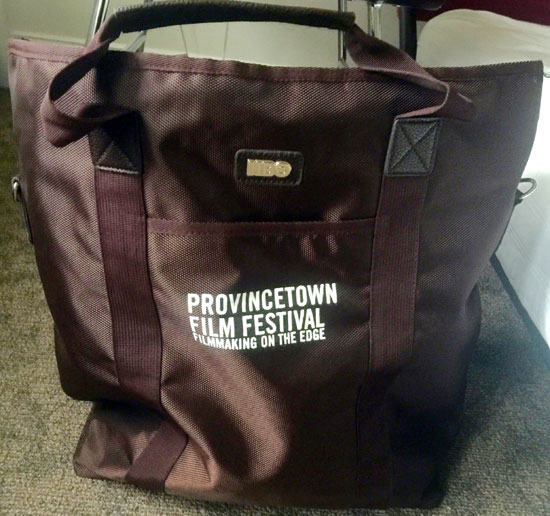
Swag (Provincetown Film Festival 2015)
Provincetown Film Festival 2015
Vivian Bresnitz
June 23, 2015
4:14 AM, Ugh. My head dropped back to the pillow while my brain ran through several possible reasons why I didn’t have to actually rise. None of the possibilities were true, not if I wanted to go to the Provincetown International Film Festival in Provincetown, MA and make it to the “PIFF Breakfast with…” series in time…..
THE FILM FESTIVAL!! GET UP!!

Panelist: Michelle Boyaner (Provincetown Film Festival 2015)
Seventeen years ago, I attended the first Provincetown Film Festival, my first festival ever. I carefully picked out a few select movies because a few were all I could afford. I also didn’t attend any of the related festivities because of the added cost. That remained true for me, still, years later. Joshua Selman of Artist Organized Art, recently handed me the fantastic opportunity to write about the 2015 Provincetown International Film Festival and attend it in full. I will be forever grateful. The chance to see so many films in a span of a few days was heady and an incredible treat. Definitely, Bucket List material.
Once on the road, I arrived in Ptown, as it’s also known, three hours later (it ordinarily takes 3+3/4 hours without traffic) at the morning event, almost on time. Kory Mellon, one of the Film Festival’s Publicity facilitators and Press Contact/Obscure Pictures, greeted me at the door, in order to hand me a ticket for entry. (Kory was to be key to my peace of mind that week: He helped with tickets, my sometimes inane questions, and last minute changes. I couldn’t believe how he maintained that sweet, calm persona amidst all the flurry. A special shout out goes to him.)
I quietly entered the room, put my things down on a chair and scoped out the people, the food and my first objective. Coffee. Thank God. There’s coffee.
After the Discussion ended, I raced off to the Sage Inn & Lounge to pick up my Press badge, itinerary, etc., since there hadn’t been enough time beforehand and my heart skipped a beat at the sight. It wasn’t for a famous face: it was for the swag handed to me! And there on a side buffet was yet more food and dessert! This writer/photographer pretended to be cool and matter of fact about it but inside, I was acknowledging the swoon. I could get used to this.
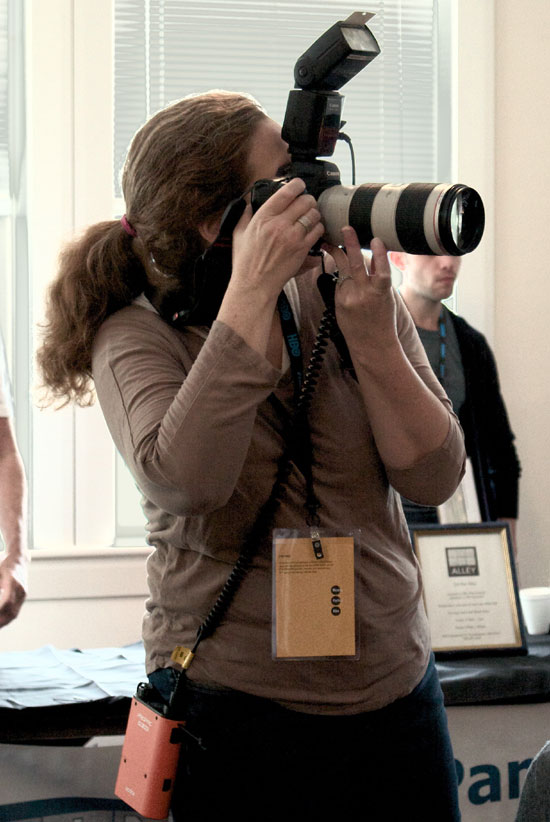
Pro (Provincetown Film Festival 2015)
The “Breakfast with…” series occurred each morning of the festival, offering the opportunity to hear directors, producers, and actors talked about their work, the industry and this particular venue. To quote one director, Andrea Meyerson: “I like to draw people in with humor and then make them cry.” Michelle Boyaner said, “I can’t die without these stories being told.” Director, Sebastian Silva expressed an astute observation about the difference between American audiences and others. To paraphrase, “American audiences seem to have higher expectations about being amused. They also have stronger expectations about a movie’s outcome and seem to be less open to surprise.”
Making sure to experience bits of all of the PIFF, a party, talks and certainly as many of the 87 feature-length and short films as I could sanely do in a few days were on the agenda. (I always make a point to see Shorts at film festivals, since they’re not bought nor distributed as “easily” as feature films.) During this 2015 festival, I must say, I saw mostly quite notable films. A few were mediocre, a few even made me wonder why they were there, but largely, I was moved by what I viewed.
A few of the worthy films I must mention here are LEARNING TO DRIVE (USA, Directed by Isabel Coixet and HBO’s 2015 Audience Award / Best Narrative Feature winner), RADIATOR (UK, Directed by Tom Browne), PEOPLE, PLACES AND THINGS (USA, Directed by Jim Strouse.) and BREATHE (France, directed by Mélanie Laurent.)
These feature films are touching, emotional, and/or funny in places, and well done. The films are both timeless and current in subject matter, and all had me shedding a tear or two.

Panelists: Andrea Meyerson, Alan Chebot, Michelle Boyaner, Howard Karren
(Provincetown Film Festival 2015)
In LEARNING TO DRIVE, a woman reluctantly challenges herself to push beyond her fears, after being left by her husband. She learns unexpected lessons by and about her teacher, in the process.
RADIATOR is a visceral and tender piece about dealing with aging parents, portraying love, obligation and innate humor.
PEOPLE, PLACES AND THINGS is such a sweet and ironic slice of life about a man trying to be a good father to his twin girls, navigating the breakup of his marriage and the relationship with his ex-wife.
BREATHE, based on a best-selling French Young Adult novel, RESPIRE, should definitely come to your local Indie movie house. An iconic presence, the pains and mysteries of adolescence and the power of peer pressure, along with a surprise ending make this movie hypnotic and disturbing. The John Schlesinger Award, presented to a first time documentary and narrative feature filmmaker went to this film.
Also, a gem of a documentary piece, PACKED IN A TRUNK, (USA, directed by Michelle Boyaner, and HBO Audience Award / Best Documentary Feature winner) plays part mystery/part whodunnit (sort of), offers an important missing piece to Provincetown’s rich art history and inadvertently lured me to the Provincetown Art Association Museum (PAAM) to view the discoveries. The musical score is sappy but the movie is a great, true story about love, art, family, prejudice and eery coincidences.
The chance to hear and talk with creative people in the industry ran the gamut from enticing to funny to simply… “interesting”.
Comedic Actress, Jennifer Coolidge, (American Pie, Legally Blonde, Best In Show) was in town to receive the 2015 PIFF Faith Hubley Award for Career Achievement. Faith Hubley, (1924-2001) was an Academy Award-winning filmmaker, actress, artist and animator. Past honorees include Mira Nair and and Debra Winger. In the onstage interview (and on break from theatre work in Boston), Ms.Coolidge said,”My life has gotten much simpler: dogs and friends.”
I could have passed on the Bobcat Goldthwait interview (Filmmaker, former standup comic and 2015 PIFF recipient of the Filmmaker On The Edge Award) with Provincetown artist in resident and filmmaker, author and PIFF vital, John Waters [who’s work I love]. A bit of the Adolescent [Straight] Male thing going on there, in my opinion.
Later in the week, one of the fun, unplanned “moments” happened with a chance meet and personal discussion with Bryan Horch, a filmmaker involved with IN THE HOLLOW, (USA, Directed by Austin Lee Bunn) Coming out from the dark room, Bryan asked a few of us who lingered afterwards, our thoughts of a plan to make this film into feature length. The lively talk went on so long the staff was eventually pushing us out the door. This Short, by the way, is a gripping piece, based on the real life case of two women, lovers, hiking the Appalachian trail, decades ago, the terrifying encounter they experienced in the woods and the historical legislation that came of it.
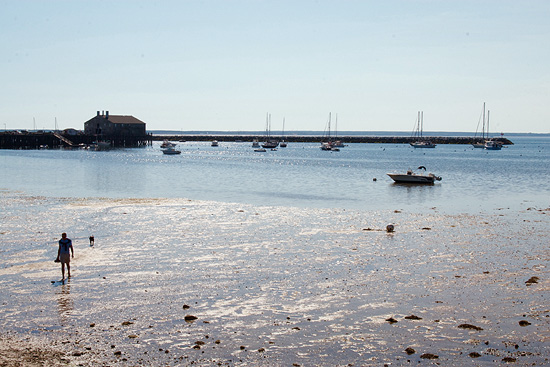
Ptown pastime (Provincetown Film Festival 2015)
Perusing the Festival’s schedule initially, I happily noticed that there were a higher number of films directed by women than I’d seen before at this [or other] film festival(s.) On reading the results for the 2015 PIFF Awards*, announced on the last day, I estimated that about 75% of the Awards went to women filmmakers! Quite impressive and encouraging.
A side note about my assignment as a badge-wearing Press participant: The first day I attended, I took photographs with an older Canon digital camera and used my iPhone for note-taking. I was aware of the professional photographer present, moving about utilizing some of the best and latest equipment. On my third day there, just before I arrived at another of the Breakfast discussions, my camera inexplicably broke down.
With no other choice, I photographed with my iPhone for the remaining time. I was wearing a Press badge, shooting with an iPhone in front of my face. (Don’t get me wrong: I think iPhones are great for photography. In fact, I bought the 6plus especially for its camera. )
Wearing a Press badge and shooting with an iPhone when there’s an established Pro nearby sporting the big girls’ equipment: a humbling experience. Note to self: Always bring an extra camera body!
Great or even good films can take us away or take us inside. Inside ideas, inside of feelings, inside others, inside ourselves. We are spoken to and we, sometimes, talk back. This visual medium draws me in like a multi-sensory hypnotic stimulant; like a delicious, intoxicating drug. Only, I remember things later.
Having been saturated and sated with four (out of five) days of the 17th Annual Provincetown International Film Festival, here’s what I learned, besides Camera Equipment 101: If you have a passion for film, put your pennies together and take the time to fully attend a film festival. DO IT. If you love movies. If you DO movies. For an aspiring filmmaker or any other kind of film/video/photography Creative, this could be as important as supporting your own [likely under-funded] work. The excitement, passion, camaraderie, talent and support are inspiring. And, it’s way fun.
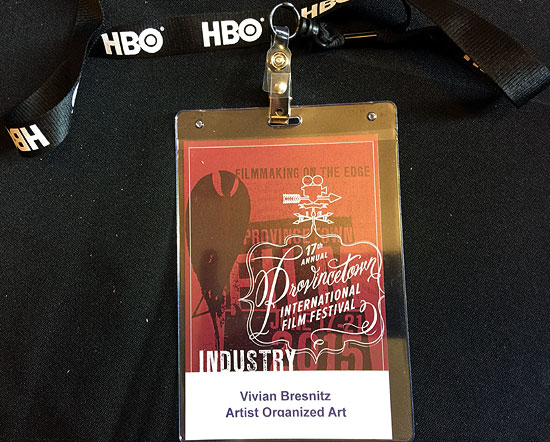
Credentials (Provincetown Film Festival 2015)
The 18th Annual Provincetown International Film Festival will be held June 15-19, 2016.
*Other Award winners:
- HBO Short Documentary Award: THE FACE OF UKRAINE: CASTING OKSANA BAIUL directed by Kitty Green
- Jury Award / Best Narrative Short Film: MYRNA THE MONSTER directed by Ian Samuels
- Jury Award / Best Animated Short Film: SYMPHONY NO. 42 directed by Réka Bucsi
- Jury Award / Best New England Short Film: AWESOME_FCK directed by Isaak James
- Jury Award / Student Short Film: SHARE directed by Pippa Bianco
The Provincetown International Film Festival (PIFF) is an annual film festival founded in 1999 and held in Provincetown, Massachusetts. The festival presents an array of American and international narrative features, documentaries and short films for five days in June of each year. With panel discussions and special programs such as Youth and Diversity and Portuguese film sidebars, the festival makes a special effort to honor and incorporate the unique cultural, historic, and artistic character of Provincetown with its thriving art colony, its large gay and lesbian population, its original Native American and Portuguese heritage, and its congenial scenic setting. In keeping with its edgy mission, the festival often presents films about countercultural figures, such as John Lennon, Beat poet Allen Ginsberg, and writer William S. Burroughs. The festival is a program of the Provincetown Film Society, the non-profit parent organization which also operates the year-round Waters Edge Cinema (formerly known as Whaler’s Wharf Cinema), a year-round Provincetown movie theater presenting what it considers the best in current independent and international cinema.
Vivian Bresnitz appears here as a correspondent for Artist Organized Art, she lives in Western Massachusetts also working as a Licensed Massage Therapist. Vivian has been in practice for over 20 years. Her business is Well Being Therapeutic Massage.
Wednesday, June 3rd, 2015
Flux-Labyrinth
an Interview with Larry Miller
Frieze Art Fair, New York City 2015
May 27, 2015, New York City
The Frieze Projects 2015 Tribute to the Flux-Labyrinth (1976/2015) organized by Cecilia Alemani. The original Flux-Labyrinth, organized by George Maciunas, was realized in 1976 at the Akademie der Kunste in Berlin. This video by Clara Joy includes images by Mark Bloch and video clips by Clara Joy.
Interview: Larry Miller on the Flux-Labyrinth
By Mark Bloch
May 27, 2015
There have been only two “official” versions of the Flux-Labyrinth according to Fluxus artist Larry Miller but its history is becoming maze-like itself.
The first incarnation of the project was in writing. Fluxus founder George Maciunas’ 1974 “Preliminary Instruction Drawing for Flux-Maze” provided the overview for subsequent manifestations. A January 1975 proposal for the “Flux-Maze at Rene Block Gallery” on West Broadway in Manhattan never happened but since Block owned the rights, the Flux-Maze eventually did become the September 1976 “Flux-Labyrinth” as part of Berlin’s 26th Arts Festival at the Academie Der Kunst, designed by Maciunas and Miller. Joe Jones, Ay-O, Robert Watts, Yoshi Wada and others were also listed as collaborators. Miller has written, “From September 5 to October 17 of that year, thousands of participants made their way through the extensive maze of puzzling and obstacle-laden corridors. Based on ideas by numerous Fluxus artists, doors, walls and floors were altered to make passage very challenging.”
Two previous Fluxus projects, Ay-O’s rainbow staircase “Fluxfest Presentation” in November 1965 and “Portrait of John Lennon As A Young Cloud,” a maze with eight doors built by Maciunas for a May 1970 “Fluxfest Presentation for John Lennon & Yoko Ono” are listed as pre-cursors to the project in the “Fluxus Codex”. Also deserving of a mention was Maciunas’ “Flux-Combat between the Attorney General of New York,” an elaborate door-related installation designed to protect Maciunas’ residence from unwanted intruders in 1975-76.
Miller, who worked with Maciunas from 1969 to the latter’s death from pancreatic cancer in 1978, was asked to re-create the first Flux-Labyrinth from photographs and other documentation at the Walker Art Center in 1993 in Minneapolis for the exhibition “In the Spirit of Fluxus.” Miller has explained it “included the addition of elements from artists such as Geoffrey Hendricks and Alison Knowles, which were not realized in 1976.”
The next “unofficial” manfestation of Flux-Labyrinth was a “mini-labyrinth” at A1 Art Interactive in Cambridge, Massachusetts as part of the show “Do-It Yourself Fluxus” organized by Midori Yoshimoto. Miller created a plan for an “abbreviated” version “that replicated nearly one fourth of the 1976 installation.”
Finally, this month’s Frieze Art Fair on Randall Island in New York City featured a “re-creation” or “homage” to the original Flux-Labyrinth but due to previous commitments, Miller was unable to participate or provide guidance, so this latest Flux-Labyrinth became the first incarnation without it. It did feature input from Flux-artists Hendricks and Knowles who were in the 1993 version, and several recreations of designs by Maciunas, Nam June Paik and others by the Frieze staff who were careful to bill their labyrinth as a “tribute” as they did with other projects in previous years including FOOD, the artist-run restaurant project by Gordon Matta-Clark.
I spoke to Larry Miller by telephone with the hope of uncovering some of the ideas behind the Flux-Labyrinth. —Mark Bloch
MB: So you were involved in previous Flux-Labyrinths?
LM: Me basically doing work in the shadow of the great George Maciunas. The first was in the Berlin Flux-Labyrinth at the Academie Der Kunst in 1976. I went there about two and a half weeks before. I remade it at the Walker. I did the whole thing again in 1993 from photographs at the Walker. An approximately 900 or 1000 square foot thing.
Can you reconstruct “Relache” from photographs? You can probably do the 1942 Surrealist Exhibition with the string and the upside down umbrellas. You could do a decent version of that based on the photographs.
MB: You have said that the Flux-Labyrinth is a giant Fluxbox. You cited Maciunas’ concept of Flux-Vaudeville.
LM: The labyrinth stands for the puzzle. The puzzle, the maze is kind of a space-time translation of finding the location of where you are. Situating yourself. Where do I stand on this? Where am I?
MB: A meta-GPS system?
LM: A similar question, an archetypical question is, “What is consciousness?” Where the hell are we? They don’t even know that in the Congress of the United States. They don’t know it anywhere. The labyrinth is the most central issue of our era. Global warming. It’s raining thirty inches in Houston. Why is Putin taking over the Crimea? The labyrinth represents that which we do not know. Where the hell are we? This is what makes art so important. Art is something that tells us or gives us some clue of where we might be.
MB: So where are we?
LM: It’s never changed. That question hasn’t changed ever. It’s gotten more deep, there’s more depth and more details.
You look at TV and you see that Houston got 30 inches of rain in one night and eight people are dead. Something is going on. This constitutes the puzzle. The labyrinth is just a puzzle. That’s what consciousness is, a puzzle. Different artists through different ages have tried to physical-ize this… through hedges as a labyrinth or whatever. Taking it one step further, if you accept the idea the labyrinth or maze which has been with us since Stonehenge, if not before… the movement of the stars is a maze… hence the word “amazing….” It’s obvious that the idea of a puzzle… of “the question” idea… of questioning, itself, is a maze, in a very real sense. It is “The Question.”
MB: The age old question…
LM: We’re all wondering… the real question is… what’s going on? What’s happening? What’s at the bottom of this is the labyrinth, the maze, is one of the Jungian archetypes of art. It’s been physical-ized in many ways in history. You have it in “The Shining.” Stanley Kubrick. You have it in any number of movies. You have it in Robert Morris, one of the great artists of our era. You have it throughout the history of art. You have it in Roman times. It is extremely clear that what the labyrinth stands for is the question of “Where are we?”
Alice Aycock did a maze. Robert Morris did a maze. There’s nothing Fluxus about it. The only thing that’s interesting about the Flux-Labyrinth is that it sends it up. It makes, instead of just a mental exercise or a physical geography trip, it makes it… it expands it. If you look at the George Maciunas’ chart, his “Diagram of Historical Development of Fluxus and Other 4 Dimentional, Aural, Optic, Olfactory, Epithelial and Tactile Art Forms,” that was why I said that the Flux-Labyrinth was essentially a giant Fluxbox. Because when we did it we were trying to engage all these aspects of experience— aural, optic, olfactory, epithelial and tactile.
While I was, in the meantime, trying to mitigate the danger that George put into it, as precautions. He had no rails! He wouldn’t let anyone in because the elephant shit had been stolen! I don’t want to speak for George nor can I or should I but it was meant to be a trip through the inner sanctum of… for lack of better words… the Flux-Labyrinth was a kind of existential substitute for 20th Century experience vis a vis art. It’s that simple. It’s a giant Fluxbox of “physical experience.”
MB: An object to be played with? A game?
LM: What I think is if you look at George’s chart… the aural, optic, olfactory, epithelial and tactile—all the senses—the fundamental idea behind the Flux-Labyrinth is Maciunas was taking that essential idea of the puzzle of consciousness—in my mind, my projection—and trying to translate it in basic 20th Century terms which to me were existential. To say existential is to say concrete. To say concrete is to say physical sensation, something stimulates the senses. If you look at his chart and the title it will become clear to you. George Maciunas was basically an existentialist trying to work things out in these terms which lead to the word, “Concrete,” which was so important to him. You must experience. Concrete experience—for humana, at least—assumes consciousness, physical awareness, mind-body feedback. The mind body feedback we take for granted.
MB: Why is it a send up?
LM: The send up is essentially Buddhist. We are fools and to know that you are a fool is a send up. To know you are mocking experience, mocking phony intellectualism—a true wise person knows they are not wise. It is only that kind of person who can send up themselves to this awareness. That “C’mon, we all know this is bullshit.”
It’s laughable, I think that’s what George understood. It is, in the end, laughable. Certainly Buddhist wise men know this. Did you ever hear an interview with the Dalai Lama? You can put it in other terms: you are taking yourself too seriously… the fear of death… all these things, in the end, are reductive to the existential reality of it. It is simply what it is and there’s no more mystery than that. I think that’s what the wise men have to say: “What’s the big deal?”
MB: So is it ironic this was being presented at an art fair?
LM: Some might say the art market at its worst is seeded in an urge to simply profit on the human need for meaning. Reverence and mystery and questioning go into making serious art. There is some deep-pitted emotional urge in true art. In the end, as I keep saying in various ways, it’s all about the search for meaning. That is the prize at the end of the labyrinth, that’s the goal, that’s what drives people forward through the thorns and thickets. That’s what people want: “meaning.” Meaning is the quest of consciousness.
Elon Musk the head of Tesla Motors and CEO of Space-X and other companies and Stephen Hawkings both were recently quoted as saying the greatest danger to the human race is artificial intelligence. Like HAL in “2001” or Skynet in the “Terminator.” Ultimately what they are saying is artificial intelligence—I deduce from what they say—what people eventually want is sense and that’s what constitutes an interesting word. What makes sense? Sense means that which we feel, that which we think we know, that which computes, that which fits our intelligence such that it has evolved. I think that is why people like Musk and Hawking fear artificial intelligence: because it may not make sense anymore. It will be beyond the human experience. The Flux-Labyrinth, meanwhile, is about sense. About all the senses as George conceived of them. The totality of your physical experience, not just cognitive challenges, not just physical challenges. All of those kinds of challenges a body would encounter in a kind of gauntlet.
MB: As in “throw down the gauntlet?”
LM: The real Flux-Labyrinth is a gauntlet for the entire sensory apparatus for the human mind-body experience. In the end it’s about not just feeling in a simple sense of feeling but in the deeper sense of feeling, what is it that is the essence of our humanity? If we don’t ask ourselves that question, we’re going to go extinct. I seriously believe that. I believe that art and particularly music, art language, music are the things that define us as a species and distinguish us from even dolphins and whales, these things at the center of consciousness. Art is about, “How conscious can you get?”
Larry Miller (www.onlyonelarrymiller.com) is an intermedia artist whose work has been presented extensively in global venues since his initial solo exhibition in New York in 1970. He was active in the development of multi-media and performance-based works in SoHo’s earliest alternative spaces, and was associated with developing new configurations in the period that gained critical currency in being described as “installation art”. Knives (1973), his renowned installation of found objects and photographs regarding homeless men on New York’s Bowery, was included in New York ca. 1975, an exhibition of defining works from the period at David Zwirner Gallery, New York in 2001. Miller has been associated with the international Fluxus group of artists since 1969. In addition to his numerous original compositions which have joined the collective’s catalog of works , he has been active as an interpreter of the “classic” scores – bringing the group’s works to a wider public and attracting media coverage such as the worldwide CNN coverage of Off Limits exhibit at Newark Museum, 1999. Larry Miller’s work has been exhibited and performed in museums, galleries, and institutions around the world, including The Whitney Museum of American Art, The Museum of Modern Art, The Guggenheim Museum, The New Museum, Gallery LeLong, Stux Gallery, and Emily Harvey Gallery in New York; Walker Art Center in Minneapolis; Museum of Contemporary Art, Chicago; San Francisco Museum of Modern Art; La Biennale di Venezia; Akademie Der Kunste, Daadgalerie and Bonner Kunstverein, Germany; Ecole Nationale Des Beaux-Arts, Paris, and other venues in Europe, Korea, Japan, Australia, Canada and the USA. His work is represented in numerous public and private collections. He has published texts and videos on art and Fluxus artists — most notably, Interview With George Maciunas, the group founder, which has been screened internationally and translated into numerous languages. In 1994, he co-curated the first Fluxus Online website. Exhibitions related to genetics include: Paradise Now: Picturing the Genetic Revolution, Exit Art, NYC, 2000 (touring U.S. through 2004); From Code to Commodity: Genetics and Visual Art, New York Academy of Science, NYC, 2003; Gene(sis): Contemporary Art Explores Human Genomics, Henry Art Gallery, University of Washington, Seattle, 2002 to 2005), Codes and Identity, Clifford Art Gallery, Colgate University, New York, 2003, How Human: Life in the Post Genome Era, International Center of Photography, New York, 2003 and DNA[do not assume], Bowling Green State University, Ohio 2005. Miller has received individual artists fellowships and exhibition grants from the New York State Foundation for the Arts, Creative Artists Program and the National Endowment for the Arts. A native of Missouri, Miller earned his MFA degree at Rutgers University, New Brunswick, New Jersey in 1970.
Mark Bloch (American, born 1956, www.wikipedia.org/wiki/Mark_Bloch) is recognized as being one of a handful of early converts from mail art to online communities.In 1989, Bloch began his experimental foray into the digital space when he founded Panscan, part of the Echo NYC text-based teleconferencing system, the first online art discussion group in New York City. Panscan lasted from 1990 to 1995. Following the death of Ray Johnson in 1995, Bloch left Echo and began a twenty-year research project on Communication art and Johnson, and wrote several texts on him that were among the earliest to appear online and elsewhere. Bloch and writer/editor Elizabeth Zuba brought together an exploration of Ray Johnson’s innovative interpretations of ‘the book’” at the Printed Matter New York Art Book Fair in 2014 at MoMA PS1. Bloch has since acted as a resourcefor a new generation of Johnson and Fluxus followers on fact-finding missions.
By Mark Bloch
Tuesday, May 19th, 2015
Hanging Out In Art
Frieze Art Fair 2015
New York City
May 15/16 2015, Randall’s Island
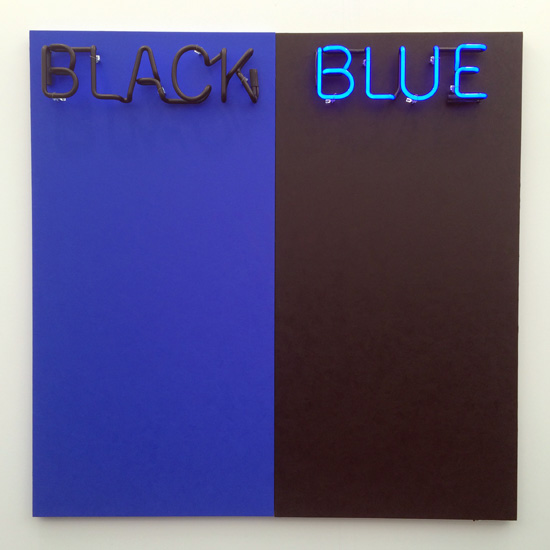
Deborah Kass Black and Blue, 2015 Oil, acrylic and neon on canvas 60 × 60 in 152.4 × 152.4 cm.
“I like that blue is in the black and black is in the blue. Neon lights are a big trend online recently, a lot on Tumblr and also on Instagram. I was planning my own shot of a motorcycle store’s neon sign last week. I wanted it for my Tumblr account. By the time it was dark enough the store had closed. The neon sign was off. I’ll have to wait. This work reminds me of it and gave me a chance to work with a neon sign. I wonder if the artist knows about the online trend. Don’t worry, I didn’t post this to Tumblr. My phone died while I was still at Frieze.”
Hanging Out In Art
by correspondent, Clara Joy
May 18, 2015
My Weekend With Alison Knowles
Whenever I hang around with Alison Knowles, my “Oma,” I feel like I’m in some kind of Flux-Labyrinth. It’s a very familiar mood at this point, since she lives surrounded by her work and surrounded by lots of books and media by and about vintage Fluxus artists. We start by talking about everyday life and we usually end up at her work in art and Fluxus. My main interest this weekend was to be with Alison to see her get an award, but I knew there would be lots of surprises. She gets awards, interviewed, commissioned and celebrated every other week. There are always at least three things going on at the same time when we’re together.
I’ve decided to write this photo essay in the spirit of Alison’s world by running three threads together in my article for Artist Organized Art. I am contributing a photo essay, where most of my thoughts are in the photos and captions, which run through an interview with Alison. I invited Alison to include an interview she was working on with Joshua Selman. The theme of the interview is her work with art environments. I like the idea of my photo essay moving through it like a person through a space. I also enter into the interview at the end to answer a couple of questions. Last, but not least, is a video at the bottom of this article where I go through the Flux-Labyrinth with Alison. In that video I’ve also included some still pictures shared by Mark Bloch, but I’ve processed them into my little video labyrinth. The piece is silent until the last few minutes and then there’s plenty of sound.
At the end of April, Alison received the Francis Greenburger Award. I heard it was a great event at the New Museum, but I couldn’t go. I’m in 9th grade.. too much school work. Two weeks later Pratt Institute awarded an Honorary Doctorate in Fine Art to Alison. Since I’m also interested in Brooklyn and Pratt Institute, I went along to the ceremony at Madison Square Garden with the idea of celebrating Alison’s award and meeting a few people who run that great institution. Shepard Fairey, Alison Knowles, James Turrell, Karen Brooks Hopkins and Holland Cotter received Honorary Doctorates and it was great to hear them speak. I’m probably working on this article because of something each one of them had to say.
It was a very exciting day with Pratt Institute, but by midnight we were very tired and had to turn in. The next day I went with Alison to the Frieze Art Fair to see her dealer, James Fuentes, at his space and to enjoy the art fair. Frieze was good enough to grant an official press pass, since I agreed to come up with something for Artist Organized Art. We also wanted to see a re-creation of the George Maciunas Flux-Labyrinth. Cecilia Alemani is the curator behind the re-creation. I first met her when I was part of the Make A Salad performance at The High Line, which I really liked. I thought I might see her at Frieze, but instead I met many other old and new friends.
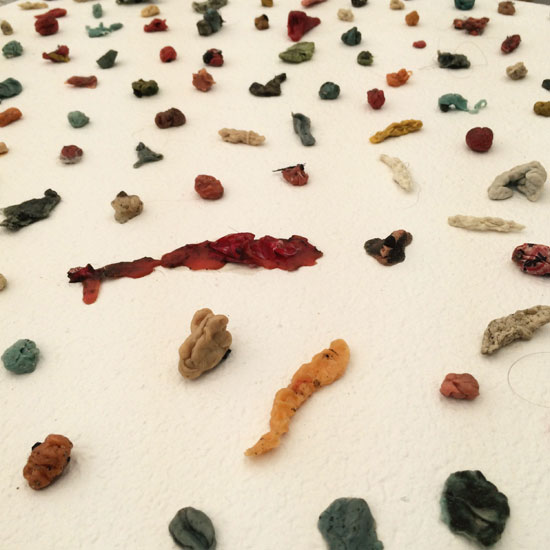
Chewing gum and detritus collected from New York’s streets by Japanese Artist: Yuji Agematsu.
“I found this very interesting. It’s an idea where we think about someone collecting gum and wonder how the artist got all of it to end up on a platform at Frieze. Did the artist just have a bag of collected gum and bring it to Frieze to install it on the table. I’ve always wondered about New York City and gum. When I was around 3 years old I learned about all those black spots on the sidewalks. The black spots on the street are apparently all made from discarded chewing gum. I’ve never really gotten over that.”
For this article I’ve invited an interview with Alison, led by Joshua Selman, about environments and art fairs (my photo essay continues in captions):
Joshua Selman: Do you see a relationship between The Boat Book as an environment and the Flux Labyrinth as an environment, in the context of an art fair devoted to visual art?
Alison Knowles: I began to be disinterested in painting after a few shows and became much more engaged with what were called actions. Dick’s Press would publish small books about performance art and I liked that we engaged by performing with and playing for people, asking them to do unusual things to think of as art such as being in art not simply standing in front of a picture and looking at it, but getting down on all fours and going through a tunnel and up a ladder.
So putting the whole person in was the idea. The Big Book was the first walk through environment that I made. We could turn the pages and close ourselves off in a little room, or again it had tunnels and ladders. It’s the same direction for the viewer to be in the work. So there was the Big Book, The Book of Bean and recently at Art Basel, Miami, the Boat Book, here at Frieze we see the Flux-Labyrinth standing out from much of the fair.
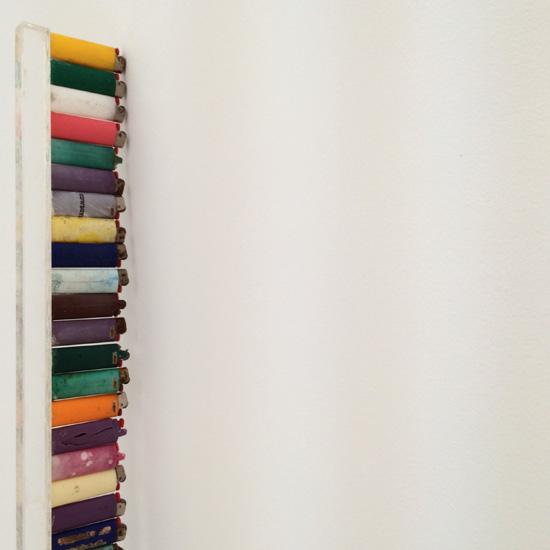
Cigarette lighters: detritus collected from New York’s streets by Japanese Artist: Yuji Agematsu.
“Lighters in a line against the wall. Many, many lighters in a line.. many more than shown in this detail view. These are all cigarette lighters found on the ground. You can tell, because they look beat up. Lately I’ve seen a lot of images with cigarette lighters found on the sides of roads with weird images on them. They’re online, mainly on Instagram and a some on Tumblr.. actually a lot on Tumblr. The lighter shots are a definite trend. I wonder if the artist knows. They’re hot, because found cigarette lighters look very vintage.”
JS: What do you think of the Flux-Labyrinth as an environmental form containing a group show? By contrast to today’s thematic group exhibits, it’s refreshing to see artists engage through parallel play.
AK: To me it all signals a move away from Museum paintings. The work we did in Fluxus as performers helped to do that. I think it’s a good thing, because, in my view being an artist, or being in art, is a very positive experience in this world and in life. It doesn’t require any special training in my book, but it does involve commitment and an ability to engage the work with people.
JS: I usually find environmental works associated with a single artist, it’s rare that a group of artists each work on a component of an architecturally unified outcome.
AK: It shows a direction away from painting and into action and engagement. We had George Maciunas directing what locations we were each working with. He knew in advance what we were going to do and I think we accepted his leadership. For Frieze, I had nothing to do with designing the labyrinth itself or with the bean garden in it. I would have done some things differently, but I know what these people are faced with economically and especially in terms of time. I go with, I go with, I go with and it’s very different from the concept of being a printer, or painting, where you’re in charge of the whole deal. I enjoy going with interaction.
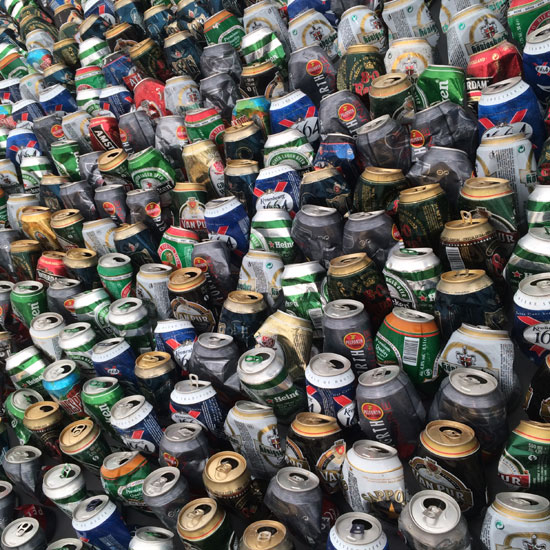
Kader Attia’s “Halam Tawaaf”, 2008, consisting of 2,978 tall beer cans.
“It’s interesting to think about how many cans there are. I mean to guess how many. Again, to think about how the artist might have collected them. I see a relationship to works where artists bring together a ton of the same stuff. This is not really trending online, but I think it’s cool. Once, I went to MASS MoCA and saw a work with piles of fresh cigarettes in rows arranged everywhere. It made an impression on me, because, you know, cigarettes are taboo. I think using quantities of the same stuff is a thing that artists do if they find the source interesting. I guess it is interesting, but it does depend on what we source and where it all ends up. This was also just a nice photo to take, but it ends up here.”
JS: In terms of scale, the Boat Book debuted at Art Basel in Miami last December at a scale equivalent to the Big Book and the Book of Bean. The Bean Garden for the Flux Labyrinth is a bit smaller, but fits into an extensive structure. How do you compare the projects?
AK: I enjoy putting people into an artwork. So, I very much go with the director who’s got to do all that negotiation and spatial organization and I accept.
JS: When you go to an environment like the Venice Biennale, that is already an environment for people to go through, how do you feel about inserting your own environment? Especially at the Biennale, imagine taking your passion for putting people through an artwork and they are already in one, how do you resolve that?
AK: We’ll see! We’ll see how it goes..
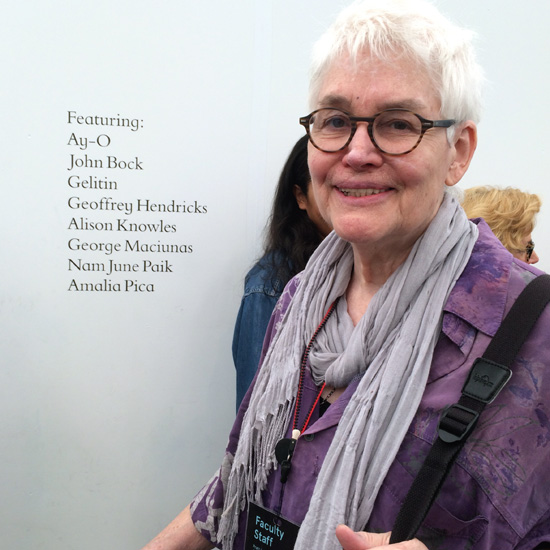
Alison Knowles stands outside the re-created Flux-Labyrinth in which there is a version of her original Bean Garden installation.
“This is my portrait of Alison Knowles at Frieze 2015. We went to Frieze together so I could meet her gallerist, James Fuentes, meet her friends, see the Flux-Labyrinth in which she has work and so I could work up a media project about going to Frieze. It’s a shot of her in front of the Flux-Labyrinth with her name in the list of participating artists on its wall. I wanted a photo of her next to the signage. People come up to Alison and say hi all the time. It’s exciting that she’s really famous wherever we go. It even rubs off on me when I’m around her. I love that and she’s a lot of fun.”
.
JS: Ah, so if you get a chance to do an environment in Venice, we will have to attend the Biennale to find out the answer to my question. Very nice, I’m buying my ticket.
AK: I arrive, put my foot in and do the best I can with it. It usually works out well enough, even for me.
JS: Would you need to go to Venice ahead of time to actually decide how you want to grapple with the issue of inserting an environment?
AK: The decisions, a lot of them, have already been made when I arrive at a biennale, by very good people, curators who have given me a space. My disposition is to work with the people who have done the hard work of getting me there, paying my ticket, housing me and giving me the prize money. I do enjoy being in the work, physically sitting in it, then people have a chance to talk with me a little as they come through a tunnel, over a ladder, look through a porthole and move through the rooms.
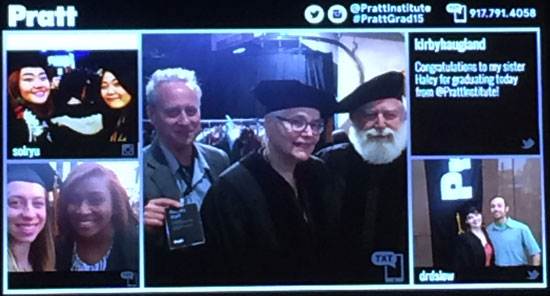
Alison Knowles & James Turrell receiving Honorary Doctorates in Fine Art from Pratt Institute the day before we went to Frieze.
“Back in her 20’s Alison graduated from Pratt Institute with a Fine Arts degree. Years later, the day before we went to Frieze, Pratt Institute would award her an Honorary Doctorate. I loved going to the graduation. Also, one of my photos of Alison was used for the commencement catalogue and Pratt Institute was kind enough to credit me in print.
At the ceremony, which was in an auditorium at Madison Square Garden, they showed big projections on an interactive screen. It was great, because you could take a photo of anyone there, especially a graduate, or whatever picture you had in your phone, or write a text message.. anything you could make on your device.. and send it to the huge screen by texting it to the number in the upper right corner. This is a photo that I texted of Alison Knowles and the artist James Turrell, which i had just taken a few minutes before at the luncheon. We got it up on the big screen. It was really exciting. I texted it there myself and then took this picture of it on the screen. Obviously each graduate isn’t going to get specific recognition unless we can project their image somewhere.
This was a good way of letting the audience in on the big screen. I’d like to use this kind of thing myself in something I do in art. I think that major pop artists like Mac DeMarco should include this in their concerts. Hashtag #macdemarco and kids at the concert or anyone streaming it over the net could be included on the big screen while he’s performing. It’s really very cool.”
JS: How do you see the Boat Book and the Big Book in relation to the House of Dust beyond the computerized poem, but as the environment described by the poem, fully realized for people to move through?
AK: Well the House of Dust was realized in honor of James Tenney who programmed and ran the miles long output of the House of Dust poem onto continuous dot matrix printer paper using a FORTRAN routine. The House of Dust is possibly the first computer generated poem and it goes on and on describing where people live, what each house is made of, the type of light it’s in and who the inhabitants are. At Cal Arts we built one iteration. I was there teaching for a few years and took people through it, stayed overnight sometimes. In California it had a beehive shape. I think these kind of installations test the premise that visual art hangs on a wall simply to be viewed. We do honor the great American painters, but most of my students are into activities and actions rather than still work.
JS: That’s very interesting. I want to ask a last question about triangulating food, shelter and clothing in art-making.
AK: Of the food pieces, I’ve done Make a Salad, or Make a Soup, for large audiences. The clothing would be Shoes of Your Choice, that’s a big favorite. We made a lot of t-shirt artworks, t-shirts with art on them.
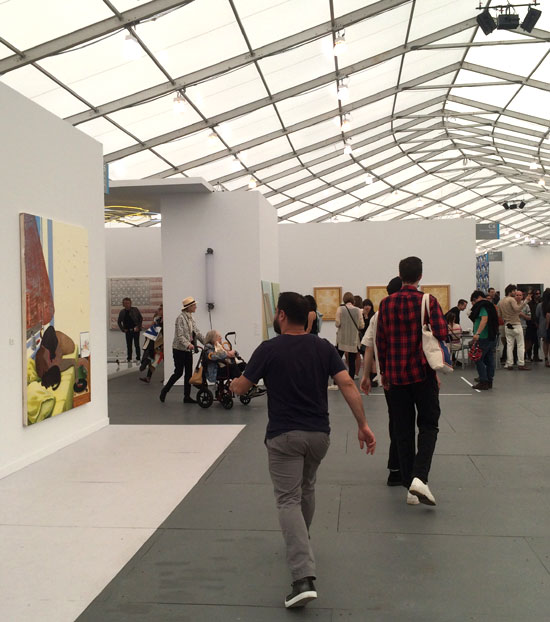
The tent at Frieze is one of the nicest features, because it lets in a lot of natural light.
“Everything looks great in natural light, especially the art works. This is a photo of Frieze itself. It wasn’t planned, I just wanted to take a random shot. I think that it came out nicely, because it frames the sunlight through the roof. That’s a very cool part of Frieze. The tent lights up everything. Frieze is one of my favorite exhibition venues, because they use the light in an excellent way. It’s not fluorescent lighting or anything gross. Screened sunlight is great for a nice fresh full spectrum result.
It’s not too hard to get to Frieze or too come back from there. You just take a ferry to Randall’s Island and the same to leave. It’s more difficult to get around at Frieze itself because it’s so big. But, it’s worth it because there’s such good art. Going to Frieze is expensive if you’re going as a spectator, but we didn’t experience that, because we got in as guests of James Fuentes, Alison’s dealer, and Frieze issued me a press pass.”
JS: You also made works on bedding and drapes, etc.
AK: Right! The whole housing thing..
JS: The clothing is where fiber takes off in your work isn’t it?
AK: Because I could print on it. I was trained as a printmaker and could make a silk screen of any size and print B-E-D on the bedding, or I could print it with a spoken text.

Jonathan Horowitz’s 700 Dots project at Gavin Brown’s Enterprise for Frieze New York 2015. I bumped into my friend Lilly, who’s friend Theodora introduced her Dad. He was spot on by dressing for the occasion.
“One of my Instagram followers met me in Chicago at The Bean a couple of years ago. Her name is Lilly and she’s great. I talk to her online a lot and messaged her about running around NYC the same weekend. We made loose plans to meet up. Then, it turned out we were both going to Frieze on the same day so we kept an eye open. By chance we bumped up in that huge crowd. She was with her friend Theodora, who I hadn’t met before.
This is a picture of Theodora’s Dad who was wearing a suit matching the installation. I had no idea her Dad was featured in the show. He’s pointing to the dot he made for the collection. It’s interesting that when we took the ferry to Frieze, he was on our boat. He knew Alison Knowles and they were chatting the whole way. No one could miss this remarkable suit. It was a big surprise when he reappeared connected to my own teenage friends and to this great social installation work. Connecting the dots makes for a small world online and again at Frieze.”
JS: By wearing, do each of us become part of a performance?
AK: It’s true! Off the wall, off the canvas.
JS: So you place people in an environment, move them through the environment, they wear the environment and you’re feeding them, as a major work. I wouldn’t mind being part of something like that in Venice. Please keep me on the short list, if and when.
AK: I remember at the Tate Modern, Make a Salad was very dramatic. We threw the greens over a balcony and four or five people tossed it with dressing in a tarp positioned beneath. Some artists have criticized this as art made from women’s work, but woman’s work was never considered performance worthy. When I make a salad for hundreds of people I also have men up there chopping. Because, I know many who do a lot of work in the kitchen. A lot of women go to the office. All the rolls are upside down today.
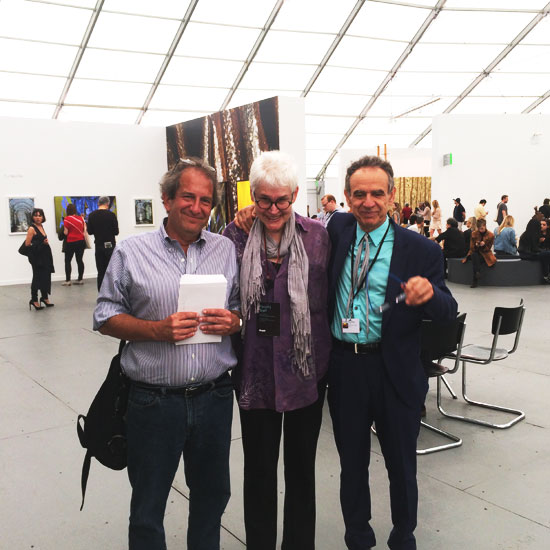
Pictured left to right: Leo Rubinfien, Alison Knowles and Juan Puentes.
“It seems so easy to meet old friends and make new friends at Frieze. I really like the atmosphere and was okay with taking a picture of these friends of the family. This is Alison with Leo Rubinfien, the award winning photographer/filmmaker, and Juan Puentes the Director of White Box, one of NYC’s most adventurous artist space galleries. Juan Puentes asked me to take the shot and send it to his cell phone right away. That can be fun, the smartphone is today’s Polaroid camera. It’s nice when patrons get the pic right away, if they pay a small fee. Just sayin’.”
JS: Food, shelter and clothing are basic to community.
AK: That’s right.
JS: “Women’s work” does that imply women are the basis of a community?
AK: Not so, not so. The House of Dust was an existing shelter in California. Earthway finally took it away, split it in half and the half that was left was put in a children’s park. It was about the size of that closet. You could go into it and crawl around. So an impermanent outdoor sculpture is transformed for play. It was great for little kids.
The Frieze Projects 2015 Tribute to the Flux-Labyrinth (1976/2015) organized by Cecilia Alemani. The original Flux-Labyrinth, organized by George Maciunas, was realized in 1976 at the Akademie der Kunste in Berlin.
“My favorite part of Frieze was going through the Flux-Labyrinth with Alison Knowles. This video is a combine of slides, with stills lent to me by Mark Bloch, and low resolution video that we took as we went through the Labyrinth. I wanted to include a video in this article, to cover the Flux-Labyrinth which, in my honest opinion, was the best part of Frieze. Alison Knowles was featured as a participating artist in the original Flux-Labyrinth and in this 2015 re-creation.
We went through a maze of crazy stuff. Just to get in we had to hack a trick door and stoop to cross a mirrored forest of low hanging material. There were a lot of obstacles made of tape and other strings. We were frequently contorted. Then we took our shoes off and walked over Alison’s garden of dried beans, which gave a welcome massage to our tired feet. That led to a hall of balloons.. more contortions in giant rubber bands. Next, we squashed by video monitors and hospital equipment in a dark room. Finally, a hallway of large, fat, half naked long haired men, screaming at us formed an exit. We actually had to squirm between their fat bellies to get out. It was kind of scary, but also really fun.
When we exited the labyrinth “Oma” had some fans waiting who were saying how much they loved her work. She mentioned her part was the bean garden where you take off your shoes and feel the dried beans as you step over them. In the video I have brown hair, a blue cap and sound like an excited 10 year old, but it was really fun.”
JS: Why are you doing so many environmental works recently?
AK: Well, I do what I’m invited to do. I’m not invited to make paintings. I’m invited to do Fluxus actions, or performances of my own, or more recently to build environmentally scaled works. Art changes around artists as they carry it along.
JS: Alison, thank you for your time and thoughts. Clara Joy, thank you for agreeing to photo journalize at Frieze for Artist Organized Art. As an Instagrammer with many thousands of followers you display your art works in public, globally, 24 hours a day, 7 days a week, and you’ve built your audience yourself from the ground up. How do you feel about the limited exposure an art fair such as Frieze provides to galleries and artists. One gallerist told me he paid $22,000.00 for a 100 square foot enclosure that lasts for 4 days. I’m not sure what if anything was sold, though I did like the display.
Clara Joy: It’s different because I post photography on Instagram and it has to do with the culture of Instagram. Frieze artists don’t really have to do directly with Instagram culture. They are trying to sell and promote their work in a different way. Work they’re showing at Frieze, and I think Frieze is great, but.. it is a lot of money for something that’s only for a very short time.
JS: You are photographing the work of other artists at the Frieze NY Art Fair. As a Teenage Instagram Photographer, do you see what you are producing as objective, or do you prefer to make new work out of the works you’re photographing? How does that work with you audiences?
CJ: It’s generally their art work, but it does have a sense of someone’s work or someone’s art when it’s posted.. like a photo of a photo at a museum. The way we take it can be our own work. If we take a photo of a painting at Frieze it is our art work, because we’re taking it in a way that’s different than the painting on the wall, but the work inside the photo is the original artist’s art work.
Alison Knowles (born 1933) in New York City is an American visual artist known for her soundworks, installations, performances, and publications. Knowles was very active in the Fluxus movement, and continues to create work inspired by her Fluxus experience. In the early 1960s, published by Something Else Press, Knowles composed the Notations book of experimental composition with John Cage and Coeurs Volants a print with Marcel Duchamp. She also traveled and performed throughout Europe, Asia and North America. In 1963, Knowles produced one of the earliest book objects, a can of texts and beans called the Bean Rolls. In 1967, Knowles and James Tenney produced the computer generated poem The House of Dust. A sound installation for a House of Dust public sculpture was produced by Max Neuhaus. The 1983 book Loose Pages, originally produced in collaboration with Coco Gordon, consisted of pages made for each part of the body. She is represented by James Fuentes Gallery, New York and recently appeared at Frieze NY Art Fair 2014/15. Since 1964, Knowles has made large and small experimental books: The Bean Rolls (1964) was a hand held, canned book of small scrolls of bean lore and information which has appeared in important artists’ books surveys alongside titles such as By Alison Knowles and More by Alison Knowles (1965/1979), Spoken Text (1993), Bread and Water and Indigo Island (both 1995). Passenger Books recently published a new collection of essays, transcribed interviews and articles and reviews related to The Big Book (1967), a walk-in book construction with 8-ft. tall pages, moving around a center spine. Knowles has continued her examination of books at various scales, from The Book of Bean (1983) to The Finger Book of Ancient Language, a table top book in Braille and other tactile languages (1987). The Boat Book (2014), commissioned by James Fuentes Gallery, appeared at Art Basel, Miami Beach, December 2014, in 2015 she received the Francis Greenburger Award. In May of 2015, Pratt Institute awarded Alison Knowles an Honorary Doctor of Fine Arts. Her original Bean Garden is included at the Frieze Art Fair, 2015, Tribute to the Flux-Labyrinth.
Frieze Art Fair is an international contemporary art fair that takes place every October in London’s Regent’s Park. The fair is staged by Amanda Sharp and Matthew Slotover, the publishers of frieze magazine. Frieze Art Fair features more than 170 contemporary art galleries, and the fair also includes specially commissioned artists’ projects, a talks programme and an artist-led education schedule. Since 2014, the magazine has also been running a New York edition, on Randall’s Island.
James Fuentes, James Fuentes LLC, 55 Delancey Street, New York City, 10002, Phone (212) 577-1201, email: info@jamesfuentes.com, http://www.jamesfuentes.com, Description: Joshua Abelow, Jonathan Allmaier, Lizzi Bougatsos, Brian Degraw, Jessica Dickinson, Berta Fischer, Lonnie Holley, Alison Knowles, John Mcallister, Jonas Mekas, Noam Rappaport, Benjamin Senior, Willam Stone, Daniel Subkoff
Clara Joy is a member of Teenage Instagram Photographers with a following that has exeeded 21,000 daily spectators. She works under several aliases. Her most well known is “softoceans“. Clara Joy considers her work online to be a form of public art. She has also worked as an assistant to Alison Knowles and prepared photo shoots and video shoots of artists’s works for major curatorial venues. She is credited as the photographer for the Alison Knowles page in the Pratt Institute Commencement Catalogue 2015. Clara Joy is one of three granddaughters of Fluxus Founders Dick Higgins and Alison Knowles.
George Maciunas (November 8, 1931 – May 9, 1978) was a Lithuanian-born American artist. He was a founding member and the central coordinator of Fluxus, an international community of artists, architects, composers, and designers. Other leading members brought together by this movement included Ay-O, Joseph Beuys, George Brecht, Dick Higgins, Yoko Ono, Nam June Paik, and Wolf Vostell. He is most famous for organizing and performing early happenings and for assembling a series of highly influential artists’ multiples.
Pratt Institute is a private, nonsectarian, non-profit institution of higher learning located in the Clinton Hill neighborhood of Brooklyn, New York, United States, with a satellite campus located at 14th Street in Manhattan. It originated in 1887 with programs primarily in engineering, architecture, and fine arts. Comprising five schools, the Institute is primarily known for its highly ranked programs in architecture, interior design, and industrial design, and offers both undergraduate and Master’s degree programs in a variety of fields with a strong focus on research. U.S. News & World Report lists Pratt as one of the top 20 colleges in the Regional Universities North category. Princeton Review recognizes Pratt as being one of the best colleges in the northeast, making it among the top 25% of all four-year colleges and universities in the United States.
Saturday, January 3rd, 2015
Temporary Distortion:
Up close and impersonal with a mediatized lens
New York City
January 3, 2015
Upcoming: ‘My Voice Has an Echo in it’
PS122′s COIL FESTIVAL in New York City
Co-presented with Ideal Glass Gallery
22 East 2nd Street
Jan 07 – 6pm to 12am
Jan 08 – 6pm to 12am
Jan 09 – 6pm to 12am
Jan 10 – 6pm to 12am
Jan 11 – 12pm to 6pm
RSVP:ps122.org
by Angie Eng
All photos courtesy of Temporary Distortion Music
on video by John Sulley from ‘My Voice Has an Echo in it’
Transcript
Perception is being reconfigured by the mediatized lens thickened by television, microscopes, binoculars, 3-D goggles, the internet and other apparati that extend how we view the world. We communicate with loved ones through Skype and Facetime. Doctors perform surgery looking through an endoscopy camera screened on a computer. War machines are driven through video game interfaces. With social media we are able to maintain intimacy and have relationships at a distance. Individuals are isolated in their living rooms sharing the same experience through a screened box. To describe an experience we may refer to a film or a viral Youtube video rather than a book or play that everyone used to have seen or experienced. These changes in habits and perception by media are not only changing the way we view the world, but also how we recreate that world in performance. The hybrid digital performances of Temporary Distortion reflect this mediatized ontology in their televisual scenography, stunted dramaturgy and non-linear approach to narrative.
I will first talk about the concept of televisual imagination depicted in their style and approach of the acting and design of their earlier pieces. Televisual imagination is creativity through a mass media gaze. It is described by theorist Philip Auslander in his book, Liveness that analyzes the impact of a culture dominated by mass media on live performance. I will quickly present images of various productions to illustrate mediatization in the style of their set design. I will show excerpts of their trilogy series that deconstructs film tropes using actors as narrators underneath video. I will conclude with their most recent production, My Voice has an Echo in it as a example of a new form of performance arising out of the mediatized gaze.
The scenography evokes a large television. Cables are strewn in piles around the set that emphasize electrical connections. Instead of hiding the machine, we are reminded of it. Performers stand or sit on the same plane, mostly in one place with a frozen gaze looking straight in the direction of -nowhere.
They are housed in shallow boxes or sets that are no deeper than a few feet. It has an illusion of the television or computer monitor whereby light initially captivates the audience before the narrative. The drama of the spectacle mimics the television’s immediacy and intimacy felt as image and sound are being transported to the viewer’s lap. When interviewing Director Kenneth Collins he mentioned of his early work, ‘As an audience member you had the sense of proximity of it, it felt immersive even though it was really small.’ His description of his set design conjures up the act of sitting and watching in front of the television and that sensation of being immersed inside of a story that is projected out with a glass window dividng you from a virtual reality a few feet in front of you.
As a painter, poet, set designer, visual artist and theatre director, Collins paints his sets with light. Spotlights directed at the audience or backlighting a static performer are devices to avoid the film over-dominating your attention.
Other scenographic tricks to ensure that all stage elements weigh in equally are: the use of monochrome primary colors such as deep blues and reds. Director Kenneth Collins describes his style of set design as ‘framed light’. Light comes alive, much like Richard Foreman’s use of blaring lights inside of a James Turrell room.
Light is warm and present. It shapes the scene in over-saturated primary color. It frames characters. It gives depth to shallowness. It manipulates your eye from one side of the motionless stage to another. Radio play comes to mind.
Theatre actor and Producer Robert Edmond Jones predicted in the 1940’s this new ontology of film in theatre, ‘slight and subtle indications of place and mood, -by ingenious arrangements of necessary properties, by the groupings of actors, by an evocation use of sound and light (Jones 145) Colored light almost become characters you can imagine being called Ruby, Sapphire, Forest or Ebony.
In his early productions, such as Someone in the Ghost Box Told Me it Was You, the video is presented on small portable monitors dispersed around the set much like in a Terry Gilliam film.
In Gilliam’s films, people have screens attached to their faces or have apparati that enable them to are look at one view through multiple perspectives. Gilliam’s style is also an example of the simulation of a mediatized gaze. In Temporary Distortion’s productions monitors are placed at eye level in relationship to the performers’ faces (on the ground, above heads, off to the side).
The inclusion of monitors with talking heads act as both object and subject technology to borrow from Jennifer Parker-Starbuck’s cyborg theatre taxonomy. As objects onstage, the video is assisting the action and representing apparatus” of the mise en scene. But these objects are activated to create a new cyborg subjectivity, a human/machine hybrid, as they stand in for the performers’ head while introducing a new digital gaze.
A quote from Auslander’s book Liveness sums up mediatized resonance that occurs between representation and re-representation in Temporary Distortion: the live and the mediatized is ‘an image of mirrors facing each other and bouncing an image back and forth between them. If the relationship between the live and the mediatized could be understood as the infinite regress this image suggests, then one would expect that after live performances had become more like mediatized ones, mediatized performances would start to resemble live performances that had internalized mediatization. Subsequent live performances would mirror those mediatized representations. And so on.’ (Auslander 187)
Here in this excerpt of Americana Kamakazi we witness the mediatization of the characters who are split between corporeal and virtual. With the use of screens the company highlights the idea that you are not looking at the actor in conflict with its virtual representation, but a corporeal body that is just one element of the stage to illustrate a story. The actor and the video representation of the Japanese female character do not seem displaced nor replaced, but actually split. She appears in a horror movie and at other moments of the performance she is in front of us narrating the movie or acting in front of us. Both serve as memory of events. Other actors appear on set as narrators as well as actors of the film that mimic the genre of the Japanese horror film.
In NewYorkLand a film is projected above the actors. We are not certain which is the signifier, the pointing finger, or signified, the concept, as they serve both simultaneously. The corporeal actor is sometimes performing to the virtual presence rather than film character supporting the spectacle narrative which we witness in the majority of employment of moving image in theatre. However, there are moments when ephemeral video describes the setting, daily habits and stereotypes of the material representation. The actor on stage represents both the cop in the film and the actuality of the cop profession. They illustrate how signified and signifier are constantly shifting roles. Traditional privileging of the material (corporeal) over the immaterial (film/video) is a less common occurrence in mediatized digital performance.
The distant gaze of the performers reminds one of side effects of the information media age. Billions of people in front of computers and televisions, absent in the room, very present on-line or transported inside media. We have all been there morphed in our chairs, only our pointer finger moves up and down like an insect antennae or the thumb on the remote moves like a lizard head. As we are immersed in front of our screen, someone enters the room and asks ‘Are you there?’ You respond, glazed-eyes wide open looking out into the world through a screen, not turning in their direction, half paying attention to your own utterance ‘uhhhh (pause) huhhh’. It’s this mood, the ‘here, but not quite present’ that Temporary Distortion captures so well in their delivery of body and voice and the feeling of absence in presence. All lines if any are delivered in a low whisper, slowly, methodically and disembodied. Yes, even creepy. Collins says of the tone, ‘ a lot of it is taking place in your mind when you are hearing sort of what they are speaking about.’ At times its even difficult to follow their non-linear narrative especially with the actors’ delivery lacks gesture and emotion.
However, video assists the narrative with the dramaturgy that is minimized on stage. In all of their work, the performers are almost petrified. In this excerpt Welcome to Nowhere a couple is recounting their thoughts and feelings without emotion as their video representations kiss above their heads. The film actors’ performances are more natural, more expressive than the performers on stage. The majority of the time the body and voice move at the same ultra slow motion pace as the video. This theatrical device taps into our ability to seamlessly jump back and forth between the video screen and corporeal actors. It is not a magical diversion. It is more like conducting in space. We are not hearing one instrument, but the whole symphony and come away with a phenomenological experience.
Imagine a pendulum tip dragging in the sand. Each time it moves from one end it pushes sand further away and then brings back sand toward the other end forming fissures and hills. With the pendulum, as the frequency increases, you see harmonics pop up even if it appears entirely random. The viewer is unable to gauge how much sand of one side was pushed over to the other. How much mediatization is in the gaze of the spectator of today and how much does the live reflect that mediatized gaze? We don’t really know. It’s probably more than we realize
But, what we do know is it’s inevitable that how we perceive the world is constantly being conditioned by media, media is formed by actuality that is then influenced by living through film, television and computers. German media theorists Norbert Bolz and William Van Reijen mention television, film and the computer are ‘frameworks that perform our perception of the world.’ The content, form and style of Temporary Distortion exemplifies what contemporary media theorist Matthew Causey described as a symbiosis of media in performance. He states in his writings on Theatre and Performance in Digital Culture: ‘Performance has taken on the ontology of the technological.’ As long as we are turning on and tuning into screens and virtual realities, we will witness more hybrid forms of performance like Temporary Distoration’s durational performative installation quasi cinematic theatre.
Angie Eng (http://angieeng.com) is a media artist who works in video, installation and time-based performance. Her work has been performed and exhibited at established venues such as, Whitney Museum at Philip Morris, Lincoln Center Video Festival, The Kitchen, New Museum of Contemporary Art, Renssalaer Polytechnic Institute, Eyebeam Art and Technology Center, Roulette Intermedium , Bronx Museum, Artists Space, Art in General , Anthology Film Archives, Experimental Intermedia and Cité de la Musique. Her videos have been included in digital art festivals in local and international venues in Cuba, France, Greece, Japan, Holland, Germany, Former Yugoslavia and Canada. For her multimedia and new media projects she has received grants and commissions : New Radio and Performing Arts, Harvestworks, Art In General, Lower Manhattan Cultural Council, New York State Council on the Arts, Jerome Foundation, Alternative Museum, and Experimental TV Center Finishing Funds and Foundation for Contemporary Arts. She has worked with composers, dancers, theatre, sound and video artists including: Ron Anderson (Molecules), Rhys Chatham, Audrey Chen, Luke DuBois, Vincent Epplay, Yuko Fujiyama, Jon Giles, Andy Grayton, Sofi Hémon, Jason Kao Hwang, Simon Hostettler, Jessica Higgins, Hoppy Kamiyama, Zach Layton, Okkyung Lee, David Linton, Jarryd Lowder, Shoko Nagai, Matthew Ostrowski, Jean Jacques Palix, Zeena Parkins, Ludovic Poulet, Rémi Préchac, Liminal Projects, Kyoko Kitamura, David Linton, Thierry Madiot, Geoff Matters, Ikue Mori, Pauline Oliveros, Jane Scarpantoni, Peter Scherer, Kevin Shea (Talibam), David Simms (Jesus Lizards), Jim Staley, Satoshi Takeishi, Yumiko Tanaka,Keiko Uenishi, Elisabeth Valletti, Vire Volte Theatre, Nancy Meli Walker and David Weinstein. She is also a European correspondent for AOA (Artist Organized Art) to support a critical dialogue between artists, art practice and dissemination via public events. She lives between New York City and Paris.
Wednesday, September 24th, 2014
MIND THE GAP in the age of the screen
Abacus | Early Morning Opera
Brooklyn Academy of Music
September 24, 2014
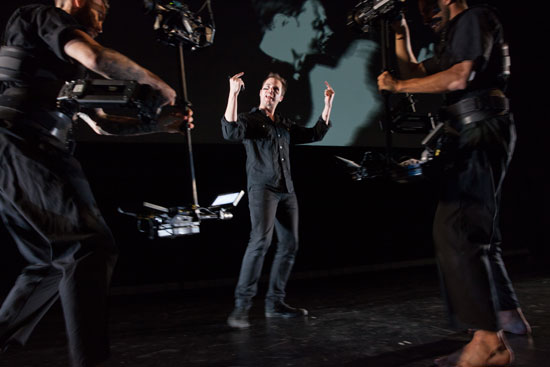
by Angie Eng
photos courtesy Max Gordon
In a country where both educational and religious institutions have been lost in the age of information and screenal technologies, something or someone will eventually, like in all nature, fill this Grand Canyon void. It is in this line between teacher and preacher where artist Lars Yan draws from forthe performance, Abacus. As long as organized religion remains exclusionary and multiple choice compliant questioning are the learning methods of choice, performances, such as this Early Morning Opera production will be considered art, rather than a spiritual awakening or a pedagogic rant. As a part of this digital age, I would rather have our children be taught in the form of a Paul Abacus presentation or, if in want/need, be religiously guided by a heightened audio-visual spectacle filled with irony and wit. But until there is an upgrade to our approach to education and spirituality that speaks more effectively to a techno-global-sophisticated audience, such audio-visual storytelling à la Early Morning Opera like Laurie Anderson will have a comfortable place in the arts.
At BAM this season, Early Morning Opera tells a story of the problematic direction humanity is heading and gives us the simple solution-humans without borders. Director/writer Lars Yan chooses to tell a story in a traditional fashion with one story teller speaking first person directly to his listeners. Hence, the press release likens Abacus to a Ted Talk. But one could equally refer to comedian George Carlin had he continued into the chapter of drones, smart phones and mega-oligarchic global unions. Better yet, Louis Farrakhan who replaced his choir with an algorithmic app. But like Ted Talk, EMO borrows techniques from the Preacher, the Comedian, the Professor and the Talk Show Host to deliver a simple message, ‘Mind the Gap’ or we are fucked and see the tactics they use to say it.
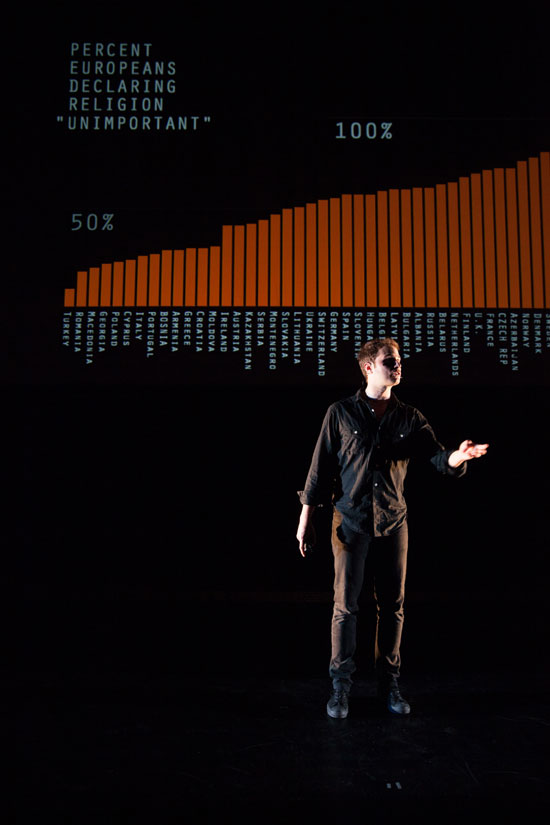
EMO’s mockery of the talk show host-preacher-teacher-statistician had me so convinced that I almost completely forgot Paul Abacus was fictional even if he has a Wikipedia page and was discussed as if he were a real person during a Ted Talk. We live in a time saturated with social-media when its possible that a 6-year old can invent an identity, such as a middle-aged man from Guatemala with a pet cobra that lives apart from her real self in real-time online. I forgot to add Second Life avatar to the list of Paul Abacus’ attributes. I wished they had gone one step further and taken the performance outside of the theatre and in front of the masses à la Reverend Billy, the artist who preaches against capitalist consumption in front of the Disney store and their partners in crime.Such faux hyper-reality performances can have more impact when context is taken into consideration. If the artist is committed to confining their work to an art space, then the concept of creating a character who appears in the real world as a real person has his limits within the black box theatre. This was less the case when Abacus was presented at Sundance’s New Frontiers Festival 2012 when credit of the performance was given to Paul Abacus instead of Lars Yan. It was equally disappointing when Da Ali G came out as Sasha Baron Cohen. Pee-Wee Herman was much more faithful to himself.
In this version, Paul Abacus does attempt to step off stage and into the real world, or rather he brings us to his world (view). He physically moves above and beyond us. Front center or in the audience he lets us know that the proscenium is the world. On screen he becomes a symbol like the starry display of the universe. He captivates our attention while keeping our heads spinning looking up, at and through the screen, behind us as he runs upstairs and offstage, to the left, to the right and even further out into virtual space.
Actor Sonny Valicenti embraces his role as Paul Abacus and smoothly switches gears from one subject to the next at a speed that correlates to the average attention span of the multi-tasking ADHD screenal being. Paul Abacus bounces between reminding us of the inequality in distribution of resources, the wars, inhabiting the moon, the sub-primes scandal, blah, blah, blah. Abacus is borderline Asperger’s. He gestures to his screen to make his point via 3-D data visualizations. Here EMO makes a comment on the negative consequence of the information age- disinformation. Like most statistical analysis, ridiculous conclusions and analogies are constantly generated to fulfill the propaganda machine. (the decrease of Catholic school attendance to the increase in consumption of Kashi cereal. )
There are short, albeit impressionable, poetic moments where EMO reminds us we are in the theatre. At one point, the two on-stage camera men escape their anonymity/invisibility and break out in Fred Astaire moves mimicking either floating satellites or mirroring the movement of statistical graphs. Paul Abacus recedes in the background while this little dance soon disappears as it appears.
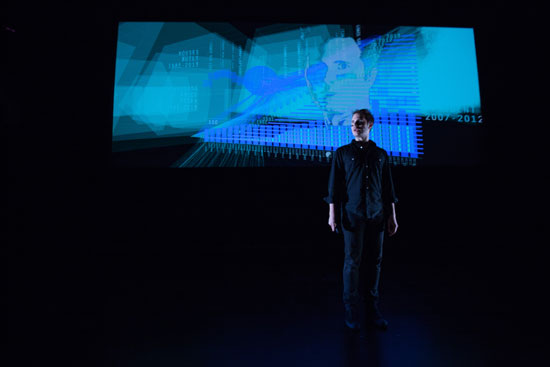
The visual props are reminiscent of 1970’s experimental video with its low resolution contrasted with today’s design trend of 3D data maps and our fond memories of watching David Letterman running back stage. The live video and animations literally illustrate or echo the actor and his words. All of this staging- the black box, the camera men, the live video feed, the giant screen, the ranting voice, the data graphs, the charisma are props that point out the various forms screen-based humans practice to persuade, to sell, to reason in an age where we can no longer just speak words to tell a story.
Angie Eng (http://angieeng.com) is a media artist who works in video, installation and time-based performance. Her work has been performed and exhibited at established venues such as, Whitney Museum at Philip Morris, Lincoln Center Video Festival, The Kitchen, New Museum of Contemporary Art, Renssalaer Polytechnic Institute, Eyebeam Art and Technology Center, Roulette Intermedium , Bronx Museum, Artists Space, Art in General , Anthology Film Archives, Experimental Intermedia and Cité de la Musique. Her videos have been included in digital art festivals in local and international venues in Cuba, France, Greece, Japan, Holland, Germany, Former Yugoslavia and Canada. For her multimedia and new media projects she has received grants and commissions : New Radio and Performing Arts, Harvestworks, Art In General, Lower Manhattan Cultural Council, New York State Council on the Arts, Jerome Foundation, Alternative Museum, and Experimental TV Center Finishing Funds and Foundation for Contemporary Arts. She has worked with composers, dancers, theatre, sound and video artists including: Ron Anderson (Molecules), Rhys Chatham, Audrey Chen, Luke DuBois, Vincent Epplay, Yuko Fujiyama, Jon Giles, Andy Grayton, Sofi Hémon, Jason Kao Hwang, Simon Hostettler, Jessica Higgins, Hoppy Kamiyama, Zach Layton, Okkyung Lee, David Linton, Jarryd Lowder, Shoko Nagai, Matthew Ostrowski, Jean Jacques Palix, Zeena Parkins, Ludovic Poulet, Rémi Préchac, Liminal Projects, Kyoko Kitamura, David Linton, Thierry Madiot, Geoff Matters, Ikue Mori, Pauline Oliveros, Jane Scarpantoni, Peter Scherer, Kevin Shea (Talibam), David Simms (Jesus Lizards), Jim Staley, Satoshi Takeishi, Yumiko Tanaka,Keiko Uenishi, Elisabeth Valletti, Vire Volte Theatre, Nancy Meli Walker and David Weinstein. She is also a European correspondent for AOA (Artist Organized Art) to support a critical dialogue between artists, art practice and dissemination via public events. She lives between New York City and Paris.
Wednesday, September 10th, 2014
Laini Nemett
ICA Baltimore at Platform Gallery
Tell it Slant
September 12, 2014 – Baltimore

Laini Nemett. Queensboro Seine. 82 x 61 inches. Oil on canvas
NEW PLATFORM
Abigail Parrish
Forever reinterpreted and re-purposed, a given place finds its relevance in the experience of being or getting there. Nemett’s work responds to the lived, remembered, and imagined histories that have become the anecdotal anchors of aged buildings, and the possibilities of what (and who) might enter the skeletons of new constructions. Based off of her own cardboard models and related drawings, her paintings piece together fragments of place, and the incongruous ways we arrive at our destinations. At a slant.
Platform Gallery in collaboration with The Institute for Contemporary Art Baltimore (ICA) proudly presents Tell it Slant, Laini Nemett’s new solo exhibition, opening on September 12th at Platform Gallery, located on 116 West Mulberry Street, Baltimore, Maryland. This is the fourth show of Platform, a new gallery, which functions as a commercial gallery posed between two areas of Baltimore: Mount Vernon/Cathedral Hill and Lexington Market. Collaborating with ICA works in alignment with Platform’s mission to serve various communities and organizations in Baltimore and further showcase important emerging artists such as in Laini Nemett. Furthermore, the space, opened to a local audience of Baltimore’s diverse demographics, functions to responsibly engage with all cultures, genders, classes, and races of Baltimore and the surrounding spaces. Platform Gallery is hosted on the first floor of Platform Arts Center (PAC), which provides studio spaces for young artists. Platform Gallery and PAC both share a fundamental goal: to strengthen the relationships between the neighbors and artists who are in the building and/or showing in the building.

a r t + c r u s h with works by Xinyi Cheng, Ben Degen, Louis Fratino, and David Humphrey. Curated and hosted by Platform Gallery. August- September 2014. Photo by Nicholas Otto Barton
Platform’s initiative and mission reflects the artistic process of both myself, and Lydia Pettit, co-director and co-founder of Platform Gallery and director of PAC. Personally, art has functioned as a religion for me since a young age. I believed that a religious practice should exist as a selfless, universal entity that brings reason and comfort to whoever believes. Through my undergraduate education at Maryland Institute College of Art (MICA), I have redirected this belief into the creation of exhibitions as well as a body of paintings. Going into curatorial studies as a studio artist rather than becoming an art historian has certainly humbled my demeanor and affected the way I develop projects. I have learned that exhibitions, programs, and public art hold the responsibility of reflecting on culture, and being accessible to as many individuals as possible.
Similarly to the way Lydia and I think, the concepts behind Platform’s exhibitions are simple and universal. In June we hosted a dual artist show with Jeffrey Kent and Stephen Towns, Tradition and Interpretation, which confronts the idea of repurposing traditions set as a child to create your own paths. Both artists moved to Baltimore, and have thus changed their work due to the cultural atmosphere. Our second show, Starcrossed: The Art of Baltimore Promotion looked into Baltimore’s history of promoting live music and bands, where we exhibited the priceless Globe Letterpress Collection hosted at MICA as well as contemporary poster designers and printmakers. Our recent show, a r t + c r u s h, follows the most universal concept for artists alike: the influence and adoration of another creator that results in a positive reflection on your work. This show explored the different age and cultural facets within the art community: students, graduate students, and established artists. It is important that a passerby from the local Enoch Pratt Library or the Walters may walk by and not recognize the artists – Xinyi Cheng, Ben Degen, Louis Fratino or David Humphrey – but would relate to the idea of having a crush or be attracted to the aesthetic qualities of the work.
Graduating in 2014 with a BFA has resulted in an overriding amount of pressure for most post-graduates including myself. Instead of focusing on new concepts and theories to pursue, a number of my peers are drained with the fear of failure – that not having a full-time, salaried, job with benefits immediately out of college will ruin their lives. If unaddressed, there is a cost to this fear to all of us. This is not the time to focus on the expectations of the past, but rather what the current generation of makers and artists need.
Deciding that she needed a studio to continue her practice as a painter, Lydia Pettit used her savings to buy the row-home at 116 West Mulberry Street to convert into studios for young artists. Her mission for this project was to build studios that are affordable, with the goal of filling the studios before Spring 2014. During this process, Lydia decided that the studios would function not only as a business endeavor, but also a community. Platform Gallery arose from this opportunity and has become a vehicle for artists to grow, and as a mechanism to invite the greater Baltimore communities into more open discussions with the hopes of forging a new, inclusive art scene.
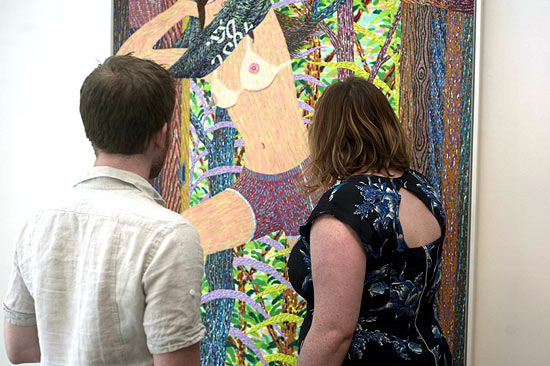
a r t + c r u s h with works by Xinyi Cheng, Ben Degen, Louis Fratino, and David Humphrey. Curated and hosted by Platform Gallery. August- September 2014. Photo by Nicholas Otto Barton
Platform promises to create driving, thought-provoking shows that question the relationship between artist, curator, and community as well as to provide opportunities for Baltimore and regional artists to show their work. Exhibitions span from showcasing emerging artists who are paving their ways into contemporary art world to curated exhibitions that investigate historical art in Baltimore. For the future, Platform hopes to extend beneficial programs involving art and the local community as well as exhibitions that reach out past Baltimore to international locations.
Laini Newmett is a New York based painter that has been a recipient of a Fulbright Fellowship to paint in Barcelona, Spain, a Joan Mitchell Foundation MFA Grant, and has participated in various residencies including the Jentel Artist Residency, UCross Foundation Residency, and the Alfred & Trafford Klots International Residency in Léhon, France. Newmett’s work explores interiors and the idea of home. Platform Arts Center (PAC) and Platform Gallery exist in a building built in the 1830’s that reflects Baltimore’s rich, urban architectural history. So, 116 W Mulberry seemed to be the perfect that reflects location for not only PAC and Platform, but for this particular exhibition, Tell it Slant.
ICA Baltimore is a collaboration of volunteers working to stage contemporary art exhibitions in available spaces in Baltimore. Tell It Slant is the twelfth exhibition by the ICA since 2011.
Platform Gallery is a commercial gallery in Baltimore, which opened in May 2014. Run by women, Platform promises to excite audiences beyond the art community, challenge convention, create new paths, and open its doors to change.
Lydia Pettit is an artist based in Baltimore, Maryland. She attended the Maryland Institute College of Art to attain her BFA in Painting. She opened and now runs Platform Arts Center, an affordable community of studios in Baltimore that hosts Platform Gallery on the first floor.
Abigail Parrish is a curator, painter and arts administrator newly graduated from MICA in 2014 with a BFA in Painting and a Concentration in Art History and Curatorial Studies.